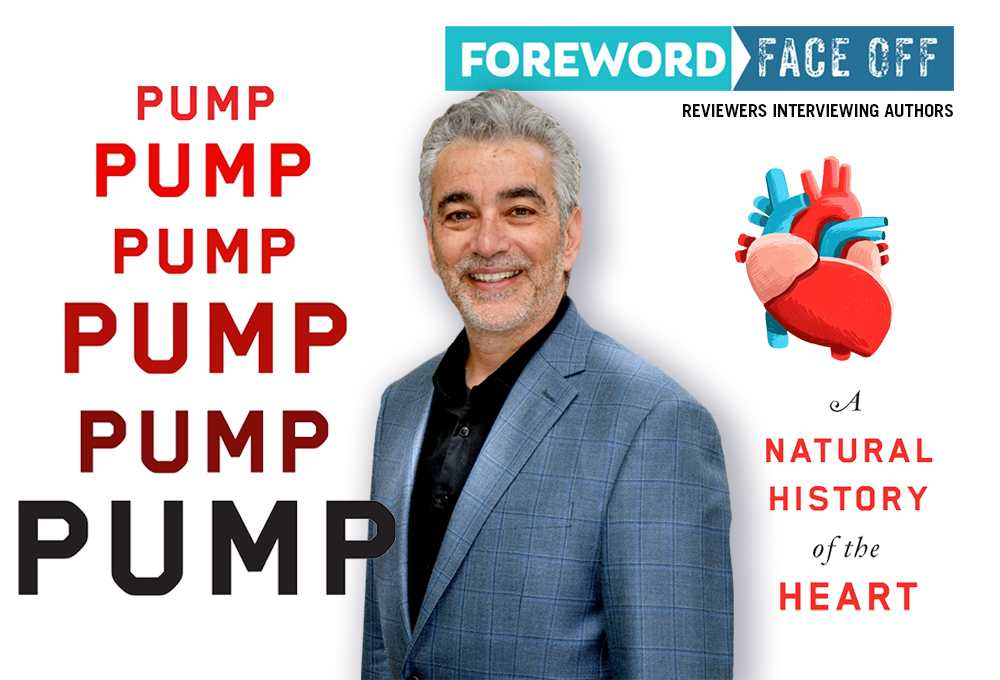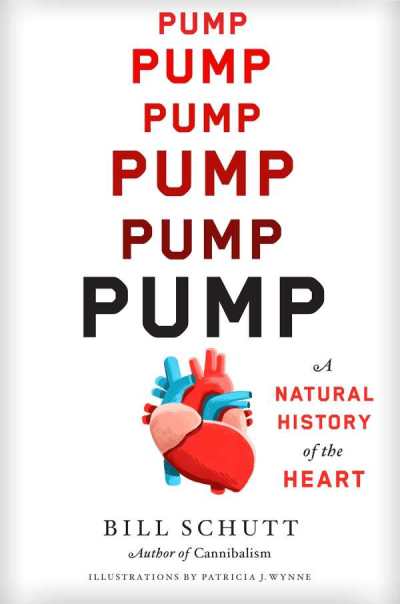Reviewer Rebecca Foster Interviews Bill Schutt, Author of Pump: A Natural History of the Heart

Consider the human heart—evolutionary wonder, critical part of our anatomy, susceptible to all manner of disorder making heart disease the leading cause of death to Americans, with many hundreds of billions of dollars going to cardiovascular research every year.
And yet, as today’s interview points out, for all our medical progress, there’s an awful lot about the heart that we don’t understand.

Meet Bill Schutt, author of Pump: A Natural History of the Heart, and just the sort of guy who can help us better appreciate the heart of the heart issues. Pump recently earned a starred review from Rebecca Foster in Foreword Reviews, so we asked Algonquin Books for help in setting up the following conversation.
Enjoy!
You open with your visit to a Smart Car-sized blue whale heart at the Royal Ontario Museum. What was it about that encounter that captivated your imagination and sparked the book?
Initially, it was the fact that, although researchers like Mark Engstrom at the Royal Ontario Museum had been working on whales for decades, nobody really knew just how large a blue whale’s heart actually was. Mark thought it might be something like a sedan size rather than the Smart Car it turned out to be. And that became an interesting story in itself, since some of the smallest vertebrates (shrews and hummingbirds) have hearts that are much larger, relative to their body size, than the blue whale’s heart—the reasons for this I got to explore in Pump.
During the initial recovery effort, mammalogy technician Jacqueline Miller and three associates forced several ribs apart, climbed inside the whale and shoved the severed heart out from the inside. Then there was the fact that the heart became the largest object ever plastinated, a massive five-year preservation effort that took place across two continents, with researchers and plastination experts often employing ridiculous amounts of seriously toxic substances. The end result is simply spectacular—and is currently back on display at the ROM in a wonderful temporary exhibit on whales.
Some invertebrates have entirely different circulatory systems. Can you give us a brief summary of those, and say why you find comparisons with the vertebrate heart illuminating?
Muscular pumps that circulate blood (or, in the case of many invertebrates, a similar substance called hemolymph) likely evolved many times in the animal kingdom. Our vertebrate hearts apparently evolved only once—and that was a tweaked version of some ancient invertebrate heart, which happen to exist in many forms. One significant difference is that vertebrates have closed circulatory systems, in which the blood never leaves the vessels that carry blood around the body. Most invertebrates have open circulatory systems, in which the blood/hemolymph gets pumped out of a structure we might call a heart, travels within a blood vessel, but then flows into a large chamber (called a hemocoel) where it bathes and supplies the nearby tissues and organs before returning to the heart.
Unfortunately, we humans have a tendency to label things like open circulatory systems as somehow defective or primitive when compared to whatever the human condition happens to be. Instead, we need to understand that all of these adaptations get the job done, and just because they’re different doesn’t mean they’re inferior.
Metaphorical understandings of the heart have been with us at least since the days of ancient Egypt. What are some of these enduring connotations, and do you think they are useful?
As you mentioned, the idea that the heart is the seat of intelligence, the soul, and emotions appears to have originated with the ancient Egyptians. Their medicine was held in high esteem by the ancient Greeks, and philosophers like Plato and Aristotle pretty much agreed with the Egyptians that the heart was the origin of emotions—including strong ones like hate and love.
This cardiocentrism was passed down to the Romans, who added their own interesting twists. One of these may have been the vena amoris, a nonexistent vein purported to run from the 4th finger of the left hand directly to the heart (please think about the significance of that particular finger among Western cultures). Not surprisingly, this heart/love connection began showing up in the arts, especially poetry and literature, where it remained and spread long after scientists began taking the so-called craniocentric stance, in which the brain, and not the heart, controlled our emotions, intelligence, etc.
Today, there are still a few people who believe that the heart is more than a pump, and that it acts more like a brain than we think. Far more widespread in acceptance are the connections between our emotional state and the health of our hearts. For the most part, though, the old cardiocentric beliefs exist today in symbolic form only. That said, one has only to consider craniocentric alternatives like Joseph Conrad’s “Brain of Darkness” and Janis Joplin’s “Piece of My Brain” to realize that this is definitely a good thing.
Heart transplantation has a long and often sad history. What did the case of Baby Fae teach cardiologists?
Baby Fae was an infant born in 1984 with an inoperable congenital heart defect called Hypoplastic Left Heart Syndrome (HLHS), in which the left side of the heart is pretty much nonfunctional. Dr. Leonard Baily, a pediatric cardiothoracic surgeon at Loma Linda University Hospital, had been successfully transplanting animal hearts between species (so called exo-transplants). He was doing this for a number of reasons, including the fact that infant donor hearts were essentially non-existent, and there were no current surgical techniques to correct congenital heart defects like HLHS in infants. So, infants like Baby Fae were essentially doomed.
In brief, Baily and his team transplanted the heart of an infant baboon into Baby Fae, who initially began to make a remarkable recovery but tragically passed away (though not from organ rejection) twenty days after the surgery. The intense, worldwide media coverage that surrounded the surgery and its aftermath not only led to many more infant heart donors (Baily performed the first successful one a year later, and a total of 200 over his long career) but led to numerous breakthroughs in surgical techniques to treat heart defects in infants. For example, HLHS can now be corrected through a remarkable trio of surgeries called a staged reconstruction that completely reroutes the flow of blood into and out of the heart. Ultimately then, and tragic as it was, Baby Fae’s story turned into a life-saver for thousands of infants.
There are moments in the history of the heart when the harvesting of or testing on animals has led to breakthroughs. What’s your take on the ethics of transplanting primate hearts and harvesting horseshoe crab blood for pharmaceutical use?
It is absolutely true that many major breakthroughs in medicine (eg, insulin, modern anesthetics, hip replacements, and heart transplants) have relied on animal experimentation. That said, I also understand those who stand for animal rights, as do many other researchers. For these and additional reasons, then, I think there has been a significant trend away from the use of animals in medical research.
For example, in the case of horseshoe crabs, there is a substance in their blood (Factor C) that clots in the presence of endotoxins (harmful chemicals released when certain bacterial cells get whacked by antibiotics or disinfectants). To the presumed relief of lab rabbits (who had been used for many years to test for the presence of endotoxins), a kit employing Factor C was developed to test sterilized surgical equipment, catheters, and pharmaceutical products for the presence of endotoxin—which can be deadly if it gets into the human circulatory system.
Once the medical community figured this out, an industry grew around the collection of horseshoe crabs on a massive scale, the draining of a large percentage of their blood, and the extraction of Factor C from that blood. This was followed by the supposedly safe return of the creatures to the wild. Unfortunately, and for reasons I learned while writing Pump, many of the crabs die in the process. More recently, though, and once researchers identified the gene responsible for the production of Factor C, they were able to crank out large amounts of recombinant Factor C, ultimately developing a test kit for endotoxin that did not involve stringing up horseshoe crabs and draining their blood.
This sort of movement away from animal testing has become a biomedical industry trend and I’m hopeful that it will continue as new technology replaces old techniques that were far more reliant on animal testing.
The book is charmingly illustrated by your longtime American Museum of Natural History officemate, Patricia J. Wynne. What is your collaboration process like?
Patricia is a dear friend and she’s illustrated every scientific paper, book chapter, novel (three of them), and nonfiction book (three more) I’ve ever written. Basically, the process starts with me giving her an extremely detailed description of what I’m looking for in the figure. For some reason she started calling these my “Spielberg Director’s Notes” but really, I’m just trying to get across what I’ve visualized in as much detail as possible—but using words instead of paint or colored pencils.
Patricia then produces a rough sketch, often suggesting slight changes to my original ideas—since she definitely knows what will work in a figure and what won’t. After that, I go over the sketch, making notes and tweaks to her artwork with an assortment of primitive scrawls and an artistic ability that would make many toddlers envious. Finally, she adds my suggested labels to the figure and anything else we’ve determined will help the reader to better understand some cool creature, structure, concept, or event. That file gets sent to the editor.
What does the future of heart treatment hold? For instance, you mention the stem cell research currently underway at Harvard.
I was lucky enough to meet and interview a number of researchers who are working to develop heart-related technologies and therapies, and some of them are as amazing as anything dreamed up by our best science fiction writers. I won’t spoil it for readers of Pump, but most of the innovations and future treatments I learned about address two serious and ongoing problems. The first is that hundreds and perhaps thousands of patients die each year while waiting for heart transplants. This is primarily because of factors like donor heart availability, compatibility, and the need to perform the transplant soon after the heart becomes available.
The second problem relates to the fact that when coronary arteries (which supply the heart muscle) are blocked, the cardiac muscle cells (and the tissue they make up) sitting downstream of the blockage become starved for oxygen and nutrients. That can lead to the death of the cardiac muscle cells in that area. Then, even if the heart attack victim survives and blood flow is restored to that area, the cells that grow back no longer contract like the cardiac muscle cells did. So, it’s like you’re replacing the parts in a mechanical pump with faulty parts. How to regenerate that functional muscle tissue is a serious focus of cardiac researchers all over the world and it’s a problem we think they’re close to solving.
Rebecca Foster
